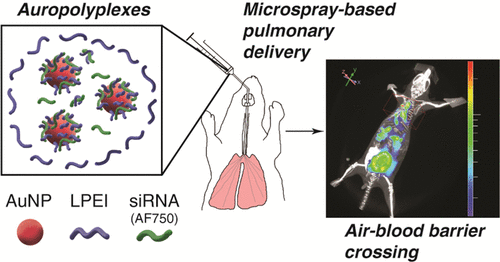当前位置:
X-MOL 学术
›
ACS Appl. Mater. Interfaces
›
论文详情
Our official English website, www.x-mol.net, welcomes your
feedback! (Note: you will need to create a separate account there.)
Combined Chemisorption and Complexation Generate siRNA Nanocarriers with Biophysics Optimized for Efficient Gene Knockdown and Air-Blood Barrier Crossing.
ACS Applied Materials & Interfaces ( IF 8.3 ) Pub Date : 2020-06-09 , DOI: 10.1021/acsami.0c06608 Alexander Taschauer 1 , Wolfram Polzer 1 , Stefan Pöschl 1 , Slavica Metz 1 , Nathalie Tepe 2 , Simon Decker 1 , Norbert Cyran 3 , Julia Scholda 1 , Julia Maier 1 , Hermann Bloß 1 , Martina Anton 4 , Thilo Hofmann 2 , Manfred Ogris 1, 5 , Haider Sami 1
ACS Applied Materials & Interfaces ( IF 8.3 ) Pub Date : 2020-06-09 , DOI: 10.1021/acsami.0c06608 Alexander Taschauer 1 , Wolfram Polzer 1 , Stefan Pöschl 1 , Slavica Metz 1 , Nathalie Tepe 2 , Simon Decker 1 , Norbert Cyran 3 , Julia Scholda 1 , Julia Maier 1 , Hermann Bloß 1 , Martina Anton 4 , Thilo Hofmann 2 , Manfred Ogris 1, 5 , Haider Sami 1
Affiliation

|
Current nucleic acid (NA) nanotherapeutic approaches face challenges because of shortcomings such as limited control on loading efficiency, complex formulation procedure involving purification steps, low load of NA cargo per nanoparticle, endosomal trapping, and hampered release inside the cell. When combined, these factors significantly limit the amount of biologically active NA delivered per cell in vitro, delivered dosages in vivo for a prolonged biological effect, and the upscalability potential, thereby warranting early consideration in the design and developmental phase. Here, we report a versatile nanotherapeutic platform, termed auropolyplexes, for improved and efficient delivery of small interfering RNA (siRNA). Semitelechelic, thiolated linear polyethylenimine (PEI) was chemisorbed onto gold nanoparticles to endow them with positive charge. A simple two-step complexation method offers tunable loading of siRNA at concentrations relevant for in vivo studies and the flexibility for inclusion of multiple functionalities without any purification steps. SiRNA was electrostatically complexed with these cationic gold nanoparticles and further condensed with polycation or polyethyleneglycol–polycation conjugates. The resulting auropolyplexes ensured complete complexation of siRNA into nanoparticles with a high load of ∼15,500 siRNA molecules/nanoparticle. After efficient internalization into the tumor cell, an 80% knockdown of the luciferase reporter gene was achieved. Auropolyplexes were applied intratracheally in Balb/c mice for pulmonary delivery, and their biodistribution were studied spatio-temporally and quantitatively by optical tomography. Auropolyplexes were well tolerated with ∼25% of the siRNA dose remaining in the lungs after 24 h. Importantly, siRNA was released from auropolyplexes in vivo and a fraction also crossed the air–blood barrier, which was then excreted via kidneys, whereas >97% of gold nanoparticles were retained in the lung. Linear PEI-based auropolyplexes offer a combination of successful endosomal escape and better biocompatibility profile in vivo. Taken together, combined chemisorption and complexation endow auropolyplexes with crucial biophysical attributes, enabling a versatile and upscalable nanogold-based platform for siRNA delivery in vitro and in vivo.
中文翻译:

化学吸附和络合相结合产生的siRNA纳米载体具有针对有效基因敲低和空气屏障穿越而优化的生物物理学。
当前的核酸(NA)纳米治疗方法面临诸多挑战,因为这些缺点包括:对上样效率的控制有限,涉及纯化步骤的复杂配制程序,每个纳米颗粒的NA载量低,内体捕获和细胞内释放受阻。结合起来,这些因素会大大限制体外每个细胞递送的生物活性NA的数量,体内递送的剂量具有延长的生物效应和可扩展性的潜力,因此值得在设计和开发阶段进行早期考虑。在这里,我们报告了一个多功能的纳米治疗平台,称为auropolyplexes,用于改善和有效地传递小干扰RNA(siRNA)。将半遥远的硫醇化线性聚乙烯亚胺(PEI)化学吸附到金纳米颗粒上,使它们具有正电荷。一种简单的两步络合方法可在与体内相关的浓度下调节siRNA的负载研究以及无需任何纯化步骤即可包含多种功能的灵活性。SiRNA与这些阳离子金纳米粒子静电复合,并进一步与聚阳离子或聚乙二醇-聚阳离子共轭物缩合。生成的auropolyplex可确保siRNA完全复合成纳米粒子,高负荷约15,500 siRNA分子/纳米粒子。在有效内化到肿瘤细胞中后,荧光素酶报道基因的击倒率达到了80%。Auropolyplexes气管内应用在Balb / c小鼠中用于肺部递送,并通过光学层析成像技术对它们的生物分布进行时空和定量研究。24小时后,肺中残留的siRNA剂量约有25%可以很好地耐受Auropolyplex。重要的是,siRNA是从auropolyplexes释放的在体内,一小部分也穿过气血屏障,然后通过肾脏排泄,而> 97%的金纳米颗粒保留在肺中。线性的基于PEI的auropolyplexes提供了成功的内体逃逸和更好的体内生物相容性的组合。综上所述,化学吸附和络合的组合赋予了具有重要生物物理属性的auropolyplex,为体外和体内siRNA递送提供了一种多功能且可升级的基于纳米金的平台。
更新日期:2020-07-08
中文翻译:

化学吸附和络合相结合产生的siRNA纳米载体具有针对有效基因敲低和空气屏障穿越而优化的生物物理学。
当前的核酸(NA)纳米治疗方法面临诸多挑战,因为这些缺点包括:对上样效率的控制有限,涉及纯化步骤的复杂配制程序,每个纳米颗粒的NA载量低,内体捕获和细胞内释放受阻。结合起来,这些因素会大大限制体外每个细胞递送的生物活性NA的数量,体内递送的剂量具有延长的生物效应和可扩展性的潜力,因此值得在设计和开发阶段进行早期考虑。在这里,我们报告了一个多功能的纳米治疗平台,称为auropolyplexes,用于改善和有效地传递小干扰RNA(siRNA)。将半遥远的硫醇化线性聚乙烯亚胺(PEI)化学吸附到金纳米颗粒上,使它们具有正电荷。一种简单的两步络合方法可在与体内相关的浓度下调节siRNA的负载研究以及无需任何纯化步骤即可包含多种功能的灵活性。SiRNA与这些阳离子金纳米粒子静电复合,并进一步与聚阳离子或聚乙二醇-聚阳离子共轭物缩合。生成的auropolyplex可确保siRNA完全复合成纳米粒子,高负荷约15,500 siRNA分子/纳米粒子。在有效内化到肿瘤细胞中后,荧光素酶报道基因的击倒率达到了80%。Auropolyplexes气管内应用在Balb / c小鼠中用于肺部递送,并通过光学层析成像技术对它们的生物分布进行时空和定量研究。24小时后,肺中残留的siRNA剂量约有25%可以很好地耐受Auropolyplex。重要的是,siRNA是从auropolyplexes释放的在体内,一小部分也穿过气血屏障,然后通过肾脏排泄,而> 97%的金纳米颗粒保留在肺中。线性的基于PEI的auropolyplexes提供了成功的内体逃逸和更好的体内生物相容性的组合。综上所述,化学吸附和络合的组合赋予了具有重要生物物理属性的auropolyplex,为体外和体内siRNA递送提供了一种多功能且可升级的基于纳米金的平台。











































 京公网安备 11010802027423号
京公网安备 11010802027423号